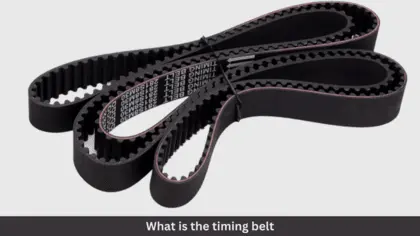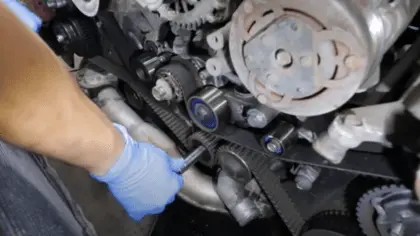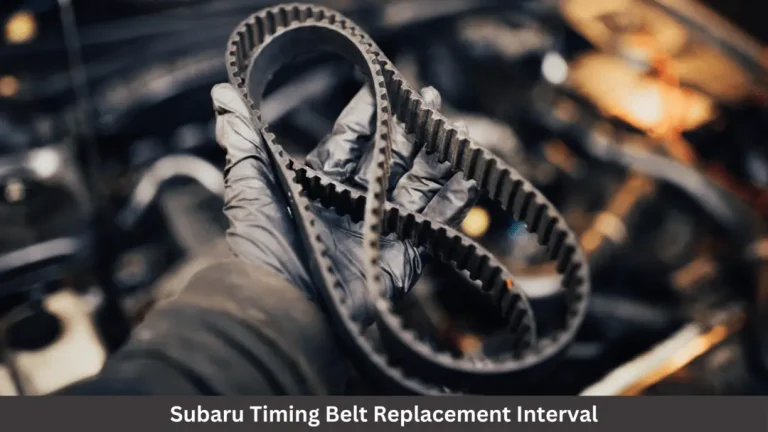One of the most critical components of your Subaru engine is the timing belt. You will rarely see any indication of its imminent failure. So, it is easy for someone to neglect it and then experience disastrous results. Your engine will suffer serious damage if the timing belt breaks when the engine is running. For these reasons, it is recommended to replace the belt at fixed time intervals or mileage. That is why you need to know about the Subaru timing belt replacement interval.
What is the timing belt?

A timing belt keeps the components on the engine in sync. This belt enables smooth running of the engine by connecting the camshafts to the crankshaft. For the engine to run correctly, the valves are required to open as well as close at the appropriate time during the rotation of the engine.
A notch too late or early could cause the engine to experience compression issues or this may lead the engine to become unable to get the proper amount of fuel/air mixture.
Both of these issues can cause the Engine Cylinder Misfire. And that is where the timing belt has its role. It keeps the components of the engine in sync.
Related Subaru timing belt: best Subaru timing belt kit.
Why timing belt replacement is important?
Timing belt replacement will avert it from breaking, which will avert big engine impairment. This is why it is so important to replace the timing belt.
Particularly, Subaru engines are interference engines, which means the breaking of the engine’s timing belt may allow the pistons and valves to collide and then cause severe damage to the components of your car engine.
If this happens, it could cost you thousand dollars to repair it. Even worse, you might need to replace the engine with a new one. Because of this, it’s highly recommended to follow the Subaru timing belt replacement interval and replace it.
What should be the Subaru timing belt replacement interval?

It would be better to consult with the manufacturer of the car regarding what should be the timing belt replacement interval of your Subaru.
Particularly, for Subaru cars, the recommended timing belt replacement time is every 7 years or 105,000 miles. This interval is based on the fact that the timing belt is constructed partially from rubber. There are two ways a rubber can decline:
Prolong use
The timing belt remains continuously under stress when the engine is running because the crankshaft keeps pulling it and it also flexes around pulleys.
Eventually, due to the engine rotations, after a certain time, the timing belt will become weak. And then it will break.
Over time
Rubber, just as many things, has a shelf life. With time, it becomes dry as well as brittle, especially if it has to endure the heat. When the rubber experiences this, cracks arise on it and cause it to break down eventually.
Take an old rubber band for example. If it stays in the sun for a long time, it will become dry and brittle. When trying to stretch the rubber, it won’t stretch. Rather, you will see it crack and break before it extends to the stretching point it is supposed to.
Replace your Subaru timing belt within the recommended interval to avoid damage to the engine as well as the extra cost that you will have to bear if the engine gets damaged.
When replacing the timing belt, what else should you replace?
Besides the timing belt, a few other things should also be replaced when you take the engine apart. Replacing them is highly recommended. These items consist of accessory pulleys, the tensioner, as well as the water pump.
When the engine is in operation, the belt stays at the appropriate tension because of the timing belt tensioner. If the belt is too tight, it will get overly stressed. And if the belt is too loose, it could skip a tooth. The tensioner of the Subaru has the same lifecycle of 7 years or 105,000 miles.
See more: how long do Subarus last?
The water pump and the pulleys should also be replaced because the timing belt drives on these components. So, if any of these components stop working, the timing belt may also fail.
Conclusion
You should always replace the timing belt according to the recommendation of the manufacturer. Subaru timing belt replacement interval is every 7 years or 105,000 miles. If you neglect the servicing of the timing belt, the belt could snap and cause serious damage to your engine. And if this happens, the cost of repair could climb up to even a thousand dollars.
So, as a preventative measure, you should replace the timing belt and the other components of the engine.


